Ancient Nara › Ancient Pyongyang » Ancient origins
Articles and Definitions › Contents
- Ancient Nara › Ancient History
- Ancient Pyongyang › Ancient History
Ancient civilizations › Historical and archaeological sites
Ancient Nara › Ancient History
Definition and Origins
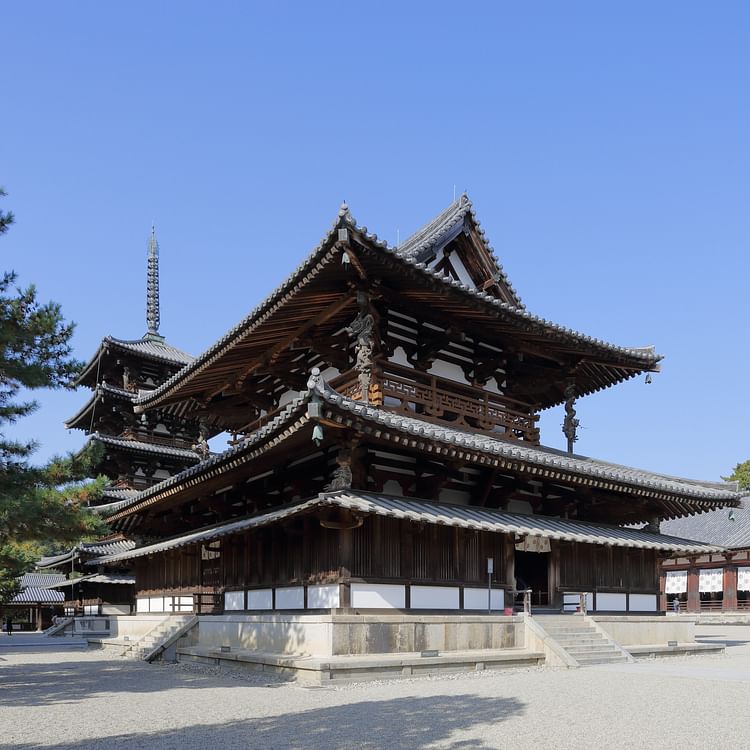
Nara, located around 30 km south of modern Kyoto, was the capital of ancient Japan between 710 and 784 CE. It gave its name to the Nara Period (710-794 CE), although the name during the 8th century CE was Heijokyo. Modelled on the Chinese Tang capital, it became an impressive city with a large royal palace, wide avenues and many important temples. Today, Nara boasts eight UNESCO World Heritage Sites, making it one of the best places to experience the architecture of ancient Japan.
A NEW CAPITAL
Nara, or more correctly Heijokyo or Heijo, as it was known then, was made the capital of Japan in 710 CE during the reign of Empress Gemmei (r. 707-715 CE), although the decision had been declared in a royal edict of 646 CE. The previous capital had been at Fujiwara (aka Fujiwarakyo), some 20 km (12 miles) to the south, but Nara had the advantage of being more centrally placed, located south of modern Kyoto, and had river access to the sea between Japan and the Asian mainland.Regularly changing capitals had, up to that time, been a feature of court life, as the royal palace and political capital were always one and the same; when an emperor died the palace was considered impure and a new location sought for. Later historians gave the new capital's name to the period 710 to 794 CE, even if for the last decade it was no longer the most important Japanese city.
LAYOUT & ARCHITECTURE
Nara was built on the Chinese model of Chang-an, the Tang capital and so had a regular and well-defined grid layout, two symmetrical halves, and the public buildings familiar to Chinese architecture. One significant difference from Chinese citieswas that Nara had no city walls, even if it did have two symbolic gates: the Rashomon in the south and Suzakumon Gate in the north. Aristocrats had their own large residences, usually in Japanese style (wooden plank flooring, wooden support frames, and a shingle or thatch roof), and their size strictly determined by the social rank of their owners. With wide avenues and low-level architecture, the city would have had a very open feel. A sprawling royal palace composed of two enclosures was built, and the state bureaucracy was expanded to some 7,000 civil servants. Emperor Shomu (r. 724-749 CE) would make the palace complex even grander.
THE TOTAL POPULATION OF NARA MAY HAVE BEEN AS HIGH AS 200,000 BY THE END OF THE 8TH CENTURY CE.
A university dedicated to the Confucian tradition was established soon after the move of capital. There, young men were trained to become officials in the state bureaucracy by learning Chinese, mathematics, and classic Confucian texts and their principles relevant to government. In 728 CE the curriculum was expanded to include Chinese literature and law.
Besides students, government officials, and court members with their household servants, the city's population was swelled by a high number of foreigners, especially from China and Korea. Perhaps 20-30% of residents were non-Japanese, settling in Nara where their skills in silk weaving, metalworking, construction, and the arts were most needed. Thus, the total population of Nara may have been as high as 200,000 by the end of the period, and it covered an area of 5 x 4 km (3.1 x 2.5 miles), much larger than its predecessor Fujiwara.
DECLINE
The Japanese imperial court was beset by internal conflicts for favours and positions amongst the aristocracy and Emperor Kammu (r. 781-806 CE) was also concerned about the growing influence of the powerful Buddhist monasteries around the city. Kammu, therefore, decided to move the capital to Nagaokakyo in 784 CE and then, after some inauspicious deaths at court, moved it again to Heiankyo (Kyoto) in 794 CE. This was the beginning of the Heian Period which would last into the 12th century CE, and Heiankyo would remain the capital of Japan for the next thousand years. Nara's population declined rapidly but the city would remain a place of pilgrimage thanks to its splendid temples, and although it suffered badly in the first year of the Genpei War (1180-1185 CE), restoration work was carried out soon after. Today the city remains one of Japan's prime tourist attractions for its examples of ancient art and architecture.

Great Buddha Hall, Todaiji
ARCHITECTURAL HIGHLIGHTS
Nara has many examples of ancient Japanese architecture (albeit reconstructed), including palace buildings, temples, halls, pagodas, and monumental gates. All eight sites described below enjoy UNESCO World Heritage Site status.
Heijo Palace
The Heijo Palace was founded in 710 CE and once occupied 5% of the capital's total area. The walled compound had 12 gates, and within were not just the royal residences and banquet halls but also a large number of government buildings and offices. The royal buildings were in the Japanese style of plain wood and shingle roofs while the government ones had the striking red painted wood and green roof tiles of Tang architecture. Abandoned when the capital moved, the site was neglected and even used for rice cultivation, but excavations in the mid-20th century CE revealed some of the former buildings and their foundations. Today, the site has been entirely reconstructed so that the Imperial Audience Hall, East Palace Garden, and Suzaku Gate offer visitors a pristine glimpse into the royal architecture of ancient Nara.
Todaiji
The Buddhist temple of Todaiji was founded near Nara in 752 CE, east of the imperial palace, hence its name 'Great Eastern Temple'. The site boasted the largest wooden building in the world at that time and covered 16 blocks of the city. The Great Buddha Hall or Daibutsuden had to be big because it contained a 15-metre (49 ft) high bronze statue of the seated Buddha, the largest such statue in the world and weighing in at around 500 tons. The Todaiji was partially destroyed in a fire during the Genpei War (1180-1185 CE) but was restored to its former glory, albeit on a slightly smaller scale but still with the new Daibutsuden housing the huge and partially restored Buddha statue and still an impressive 48 metres (157 ft) high and 57 metres (187 ft) long.

Daibutsuden, Todaiji
Other buildings at Todaiji include the Nandaimon (Great South Gate), Shoro (Belfry), Nigatsudo (Second Month Hall), Hokke-do (Third Month Hall), Shoso-in (Treasury) and two 100-metre (328 ft) tall pagodas, the latter unfortunately destroyed by an earthquake and never rebuilt. A large bronze octagonal lantern still standing between the Daibutsuden and Chumon Gate dates to the founding of the temple.
Kofuku-ji
The Kofuku-ji temple, meaning 'temple of happiness', was founded in 669 CE, when it was known as Yamashina-dera. The complex was the religious headquarters of the powerful Fujiwara clan and once had more than 150 buildings. Largely destroyed by fires in the late 12th century CE, it was partially reconstructed and benefitted from another rebuilding programme in 1881 CE. The star attraction is the five-storey pagoda which was first built at the site in 725 CE. Destroyed a number of times, the present structure dates to 1426 CE and, built using traditional techniques and without any nails, it is an impressive 50 metres or 164 feet tall. Other notable buildings are the East Main Hall (Tokondo), which was first built in the 8th century CE and whose present reincarnation dates to 1415 CE, the Northern Octagonal Hall, which today's version dates back to 1210 CE while the original was built in 721 CE, and the Southern Octagonal Hall, which was built in 813 CE with today's structure dating to 1741 CE. These buildings and a museum at the site all contain valuable examples of ancient Buddhist art.
Yakushi- ji
The Yakushi-ji Temple, headquarters of the Buddhist Hosso sect, was originally founded in 680 CE at Fujiwara but was relocated to Nara in 710 CE. The three-storey East Pagoda is original and rises to a height of 33 metres (108 ft), but the West Pagoda and other buildings, including the Kondo (Main Hall), Daikodo (Lecture Hall) and Toindo (East Hall), were all reconstructed in the 20th century CE after fire had destroyed the originals in 1528 CE.
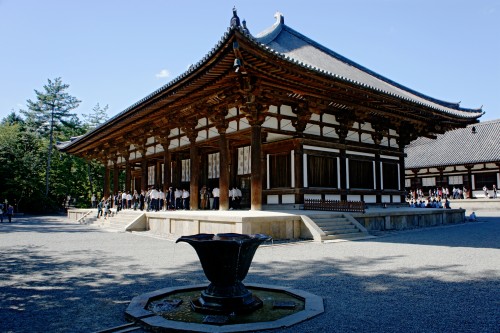
Main Hall, Toshodai-ji
Toshodai- ji
The Toshodai-ji is a Buddhist temple of the Risshu sect. Founded in 759 CE by the Chinese monk Ganjin, it boasts the largest Nara period building that has survived. This is the Main Hall or Kondo which has a distinctive facade of eight wooden columns.The site contains the burial mound of Ganjin and many important art and sacred objects - 17 National Treasures and 200 Important Cultural Properties - which include relics of the Buddha brought by Ganjin from Tang China.
Gango - ji
The Gango-ji was founded in 593 CE making it the oldest Buddhist temple in Japan. It was relocated (buildings included) from Asuka to Nara in 718 CE. The complex had seven halls and pagodas. Yet again, fire was the great enemy of Japanese architecture, and the temple was largely destroyed in 1451 CE and again in the 19th century CE. The present Main Hall or Gokurakudo, converted from the monks' sleeping quarters, does date back to the Kamakura Period (1186-1333 CE). The hall and a small pagoda are both National Treasures of Japan.
Horyuji
The Horyuji Temple near Nara in Japan was founded in 607 CE by Prince Shotoku and is the only surviving Buddhist monastery from the Asuka Period in its original state. The complex, consisting of 48 listed buildings including a five-storey pagoda, has the oldest wooden buildings in Japan.

Central Gate & Pagoda, Horyuji Temple
The Main Hall or Kondo (aka Golden Hall) of the complex is a two-storey wooden building, and its interior is made to resemble the Buddhist vision of paradise via brightly coloured murals on all four walls. There are 12 distinct panels, each measuring 3 x 2.5 metres (10 x 8.5 ft) and depicting scenes with the Buddha and bodhisattvas. Unfortunately, the original 8th-century CE wallpaintings were destroyed by a fire in 1949 CE but have since been restored exactly. There are four heavenly guardians (Shiten-no), each standing on a prostrate demon, many bronze Buddhist sculptures, and the most important objects of worship at the site, the 623 CE Shaka Triad of the Buddha and two standing bodhisattvas.
There is also a five-storey pagoda, the Treasury or Daihozoden which contains other treasures of note such as portraits of Prince Shotoku, the Lecture Hall or Daikodo, a bell tower with a distinctive flared base and a bell from the Nara Period (710-794 CE), and the octagonal 739 CE Hall of Dreams or Yumedono which is built on the site of Shotoku's palace and contains the wooden and gold -foil statue of Kannon attributed to Shotoku and the rarely seen 'hidden Buddha' known as the Guze Kannon.

Stone Lanterns, Kasuga Shrine
Kasuga Taisha
Another important Nara Period temple is the Kasuga Taisha, a Shinto shrine set in a forest east of Nara, which was officially founded in 768 CE, although historians prefer a date of 710 CE. It was established by the Fujiwara clan after, as the legend goes, a deity appeared at the site riding a deer, which also explains why deer are left to roam freely at the temple even today.The site includes a shrine dedicated to the founding ancestor of the Fujiwara. The pathway to the shrine is lined with stone lanterns donated by worshippers over the centuries. Many of these 2,000 lanterns are decorated with an image of a deer.Another 1,000 bronze lanterns hang around the shrines and gates at the site. All the lanterns at Kasuga are lit in a spectacular ceremony held each February and August.
This article was made possible with generous support from the Great Britain Sasakawa Foundation.
Ancient Pyongyang › Ancient History
Definition and Origins
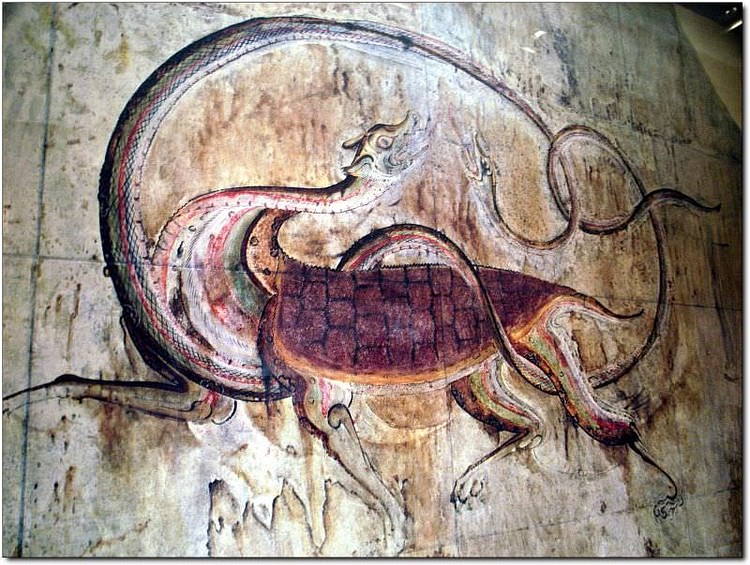
Pyongyang was the capital of several successive ancient Korean kingdoms. Located on the Daedong (Taedong) River in the north of the peninsula, the site was chosen by the legendary Dangun (Tangun), founder of the first Korean state Gojoseon(Gochoson), to be his capital city on earth. Pyongyang remained an important city throughout the following centuries and served as the capital of Wiman Joseon (Wiman Choson) and the Goguryeo ( Koguryo ) kingdoms, and was the western capital of the Goryeo (Kuryo) kingdom. The modern city, located on the same site, is today the capital of North Korea.
MYTHOLOGICAL FOUNDING – DANGUN'S CAPITAL
According to Korean mythology, as recounted in the 13th-century CE Samguk yusa ('Memorabilia of the Three Kingdoms'), the site of what would become Pyongyang was selected by Korea's legendary founder, Dangun Wanggeom (or Tangun), to serve as his capital on earth. Dangun is credited with creating the first Korean state, Gojoseon (Gochoson or Old Choson), which ruled northern Korea in the second half of the first millennium BCE. The traditional founding date of 2333 BCE has no archaeological evidence to support it, though, and historians prefer a date nearer to the 7th century BCE.
The myth of Dangun's birth – born from a union of the god Hwanung and a female bear - may symbolise the arrival of Bronze Age culture in Korea when the metal was brought from Manchuria during the second millennium BCE. The inclusion of a bear in the myth may reference the shamanistic beliefs and animal totems of the nomadic tribes who migrated from the Asian interior in this period and settled in the Korean peninsula. Evidence that the myth still carries a political resonance is seen in North Korea's claim (unsupported by scholars worldwide) to have actually discovered the tomb of this legendary figure near Pyongyang in 1993 CE and thus consider itself the true home and inheritor of Korea's first cultural hero.
PYONGYANG WAS THE CAPITAL CITY OF SUCCESSIVE NORTHERN KOREAN KINGDOMS & THE WESTERN CAPITAL OF GORYEO.
CAPITAL OF GOJOSEON
According to some historians, the state of Gojoseon was formed from the alliance of small fortified towns around the Daedong and Liao River basins perhaps from the 7th century BCE and more certainly from the 4th century BCE. An early reference to the Gojoseon state is found in the c. 100 BCE text Records of the Grand Historian written by the Chinese historian Sima Qian. Qian mentions that Gojoseon existed in 190 BCE. However, the only uncontested date for the existence of a state by the name of Choson/Gojoseon is 109 BCE and historians continue to debate whether it is possible to describe Gojoseon as a state proper, when exactly did it exist, where was its capital, and what were the exact territories under its control. The location of the capital has long been considered as being near Pyongyang, but there is also evidence that it may have been further north in Manchuria.
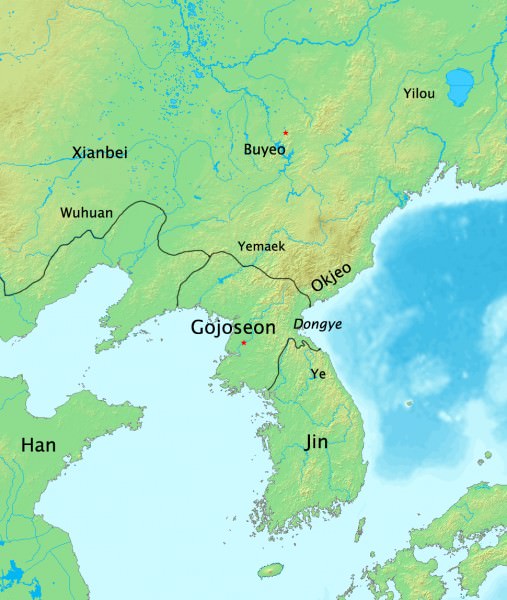
Map of Korean States in 108 BCE
Gojoseon prospered acting as a middleman for the trade between China and the southern states of Korea but was eventually weakened by attacks from the neighbouring Yan state c. 300 BCE, and a long decline set in so that when Gojoseon finally collapsed in the 2nd century BCE its territories were taken over by Wiman Joseon.
CAPITAL OF WIMAN JOSEON
Wiman Joseon was led by Weiman, a Chinese refugee (though possibly of Korean origin) who had earlier fled the Yan state.He and his 1,000 followers were given the task of protecting the north-western borders of Gojoseon by king Chun, but Weiman, or Wiman in Korean, took the opportunity to seize control of part of the country himself sometime between 194 and 180 BCE and declared himself king. Pyongyang was his capital, then known as Wanggomseong. Wiman Joseon did not last very long, and in 108 CE it was conquered by the Han dynasty of China (206 BCE – 220 CE) and the capital captured.Emperor Wu (141-87 BCE) then divided northern Korea into four commanderies directly administered by the Han central government. Pyongyang was renamed Tosongni and made the capital of the Lelang commandery (Nangnang in Korean). The Chinese would maintain control of this part of the peninsula for the next four centuries.
CAPITAL OF GOGURYEO
During the Three Kingdoms period (1st century BCE - 7th century CE) the states of Silla, Baekje ( Paekche ), Goguryeo, and Gaya ( Kaya ) all vied with each other for control of Korea. This ongoing conflict of attacks, counter-attacks and ever-switching alliances resulted in the Baekje king Kunchogo attacking Pyongyang and killing king Gogugwon (r. 331-371 CE) in 371 CE. However, by the end of the 4th century CE, Goguryeo had formed an alliance with neighbouring Silla against Baekje, allowing some, if brief, stability in the region. Beginning with the reign of Gwanggaeto the Great (391-413 CE), Goguryeo's star began to rise and Pyongyang benefitted from a rebuilding programme which included nine new Buddhist temples. Then, during the long reign of his successor, king Changsu (413-491 CE), Pyongyang replaced the mountain city of Kungnaesong as the state's capital in 427 CE. The new capital, located on a wide plain, was a much better site for an expanding metropolis which would become the thriving cultural hub of Goguryeo, one manifestation of which was the establishment of the Susowon or Academy of Books and Records which boasted tens of thousands of volumes.
In this period we know that Pyongyang had very large buildings measuring up to 80 x 30 m, and there are remains of palaces with gardens which had artificial hills and lakes. Buildings were decorated with impressed roof tiles carrying lotus flower and demon mask designs which are found in abundance at archaeological sites. There are also remains of a fortress from this period.
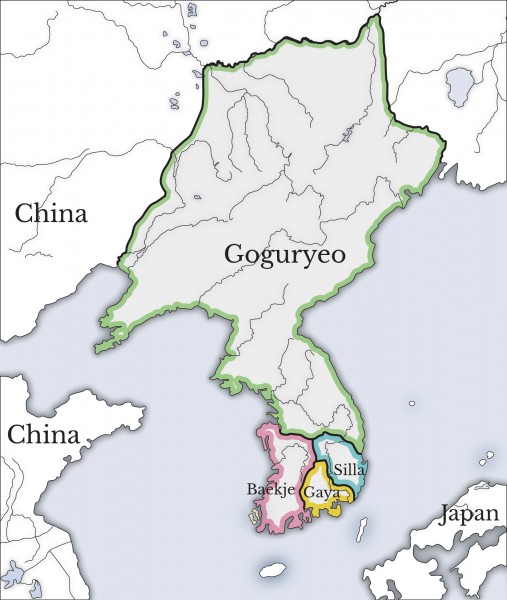
Three Kingdoms of Korea
The Silla kingdom, although much smaller, wisely sought an alliance with their powerful neighbour China to defeat their Korean rivals. First, the Sui were persuaded to send a massive army to besiege Pyongyang in 612 CE. The city stood fast and, in tricking the Chinese into thinking Goguryeo was settling for peace terms, the retreating Sui army was crushed by general Eulji Mundeok. The Sui would attack twice more without success but Goguryeo's resources were being stretched to the limit.
Undeterred by the resilience of Goguryeo to attack, the Silla kingdom, 50 years later, enlisted the help of the new Tang dynasty. The Tangs were keen to play these troublesome states against each other and so gave support to SilIa with the plan to take over the entire peninsula once the other states had been defeated. Accordingly, in 661 CE, a Tang army besieged Pyongyang, which was at that time weakened by an internal power struggle for the throne. The Tangs were forced to withdraw, but when they attacked again in 667 CE, the city, although holding out for a year, finally fell. In 668 CE the Goguryeo king Pojang (r. 642-668 CE) was removed to China along with 200,000 of his subjects in a forced resettlement programme and Goguryeo became a Chinese province. The Tangs established their Protectorate-General to Pacify the East at Pyongyang.
WESTERN CAPITAL OF GORYEO
As it turned out the Silla kingdom managed to resist Tang territorial ambitions in Korea and, forcing the Chinese out of the old Goguryeo territories, themselves established control of the peninsula, creating the Unified Silla kingdom in 668 CE.Pyongyang was, once again, brought under Korean rule. The Silla kings and queens reigned until 935 CE when the old kingdoms, revived by rebel factions, brought about its downfall. Eventually, one kingdom rose above all the others - the Goryeo dynasty (918-1392 CE). The first king, Wang Geon ( Wang Kon ), who was given the posthumous title of Taejo of Goryeo, selected the northern city of Songdo/Songdak (modern Kaesong) as his new capital as he wished to revive, and claim association with, the cultural heritage of the ancient Goguryeo kingdom.
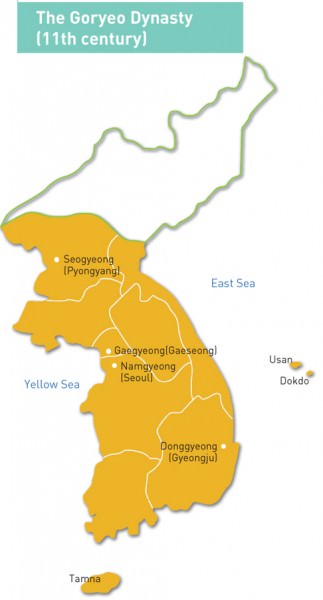
Map of the Goryeo Empire (11th century CE)
Pyongyang remained important and was chosen as the western capital because it was the traditional first capital of Dangun and the Korean people, was strategically important to protect the northern borders against the Khitan (Qidan) tribes, and met Taejo's requirements that a capital be located according to principles of pungsu (feng shui) and so benefit from the life forces of nearby natural features such as rivers and mountains. On his death, Taejo left Ten Injunctions for his successors to follow and point five specifically states the importance of Pyongyang to the well-being of Goryeo. King Cheongjeong (r. 945-949 CE) even planned to make Pyongyang the capital to reduce the influence of the aristocratic factions at Kaesong and began a preparatory rebuilding programme, but his early death put a stop to the move. Nevertheless, Pyongyang continued to hold the position of the second most important city as is illustrated by the construction of a new royal palace there in 1129 CE.
LATE HISTORY
When the Goryeo regime was challenged by the Myochong rebellion in 1135 CE, the rebels established their headquarters at Pyongyang and claimed it as their capital. The rebellion was crushed by the great Goryeo general Kim Pusik, but thereafter, Pyongyang suffered from a reputation as a dangerous place of rebellion and a consequent political and cultural neglect from the central administration. A century later the Mongols invaded Korea and occupied the city in 1232 CE. This pattern would continue over the centuries with occupation by the Chinese rebels known as the Red Turbans in 1359 CE, the Japanese in 1593 CE, the Manchurians in 1627 CE and the Japanese again in 1895 CE. The city survived all of these setbacks and, in the mid-20th century CE became the capital of the Democratic People's Republic of Korea (aka North Korea).
This article was made possible with generous support from the British Korean Society.
LICENSE:
Article based on information obtained from these sources:with permission from the Website Ancient History Encyclopedia
Content is available under License Creative Commons: Attribution-NonCommercial-ShareAlike 3.0 Unported. CC-BY-NC-SA License